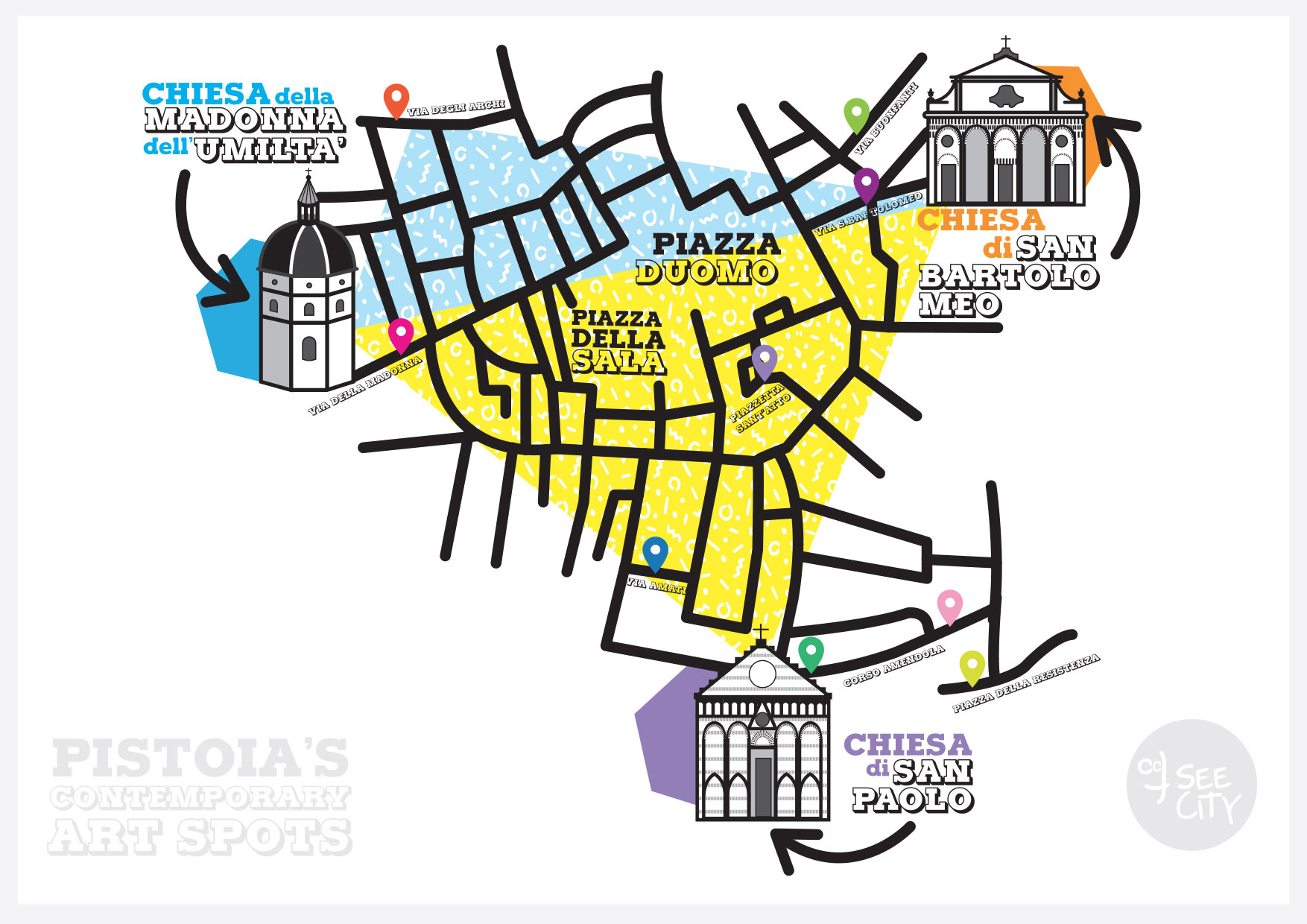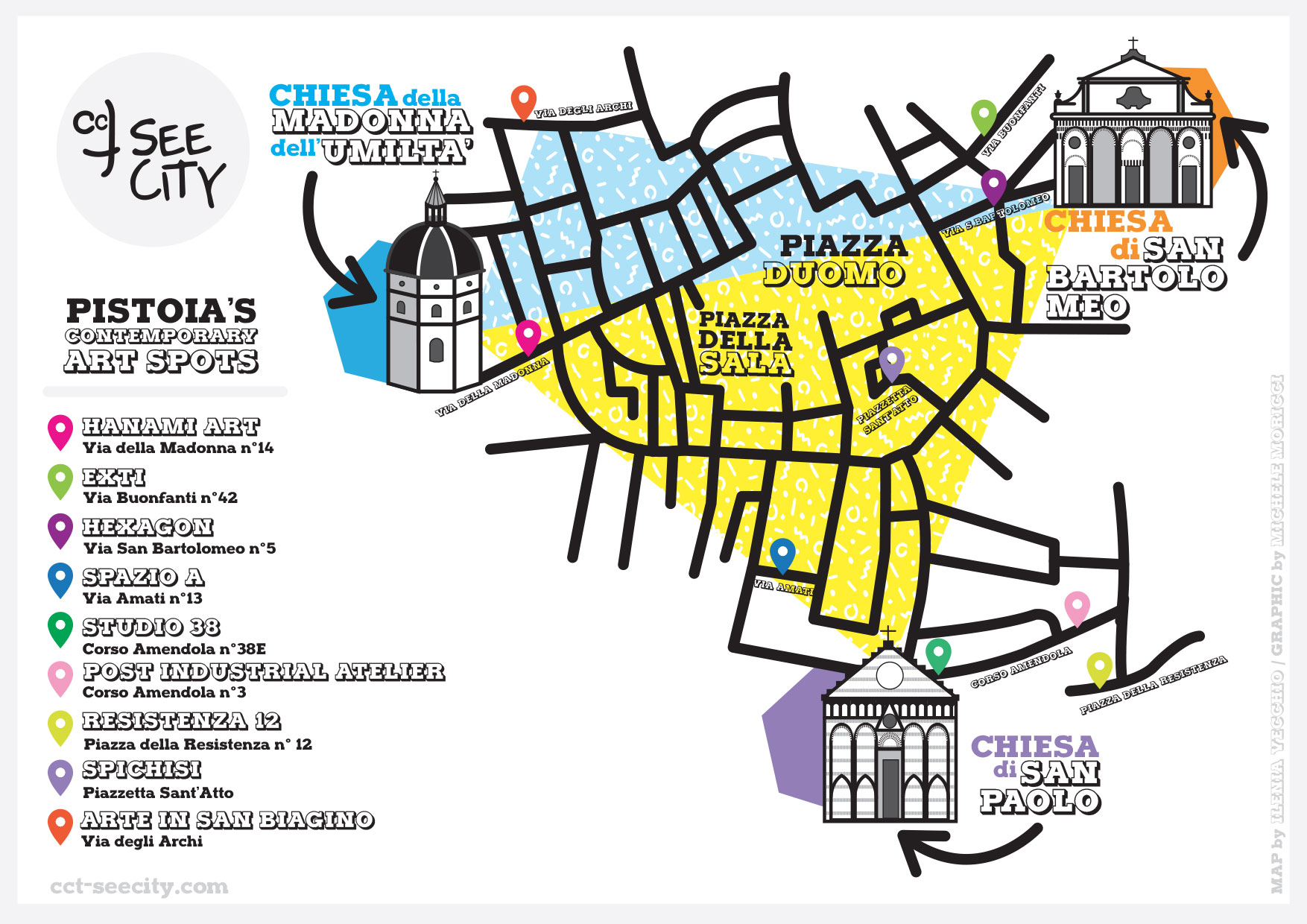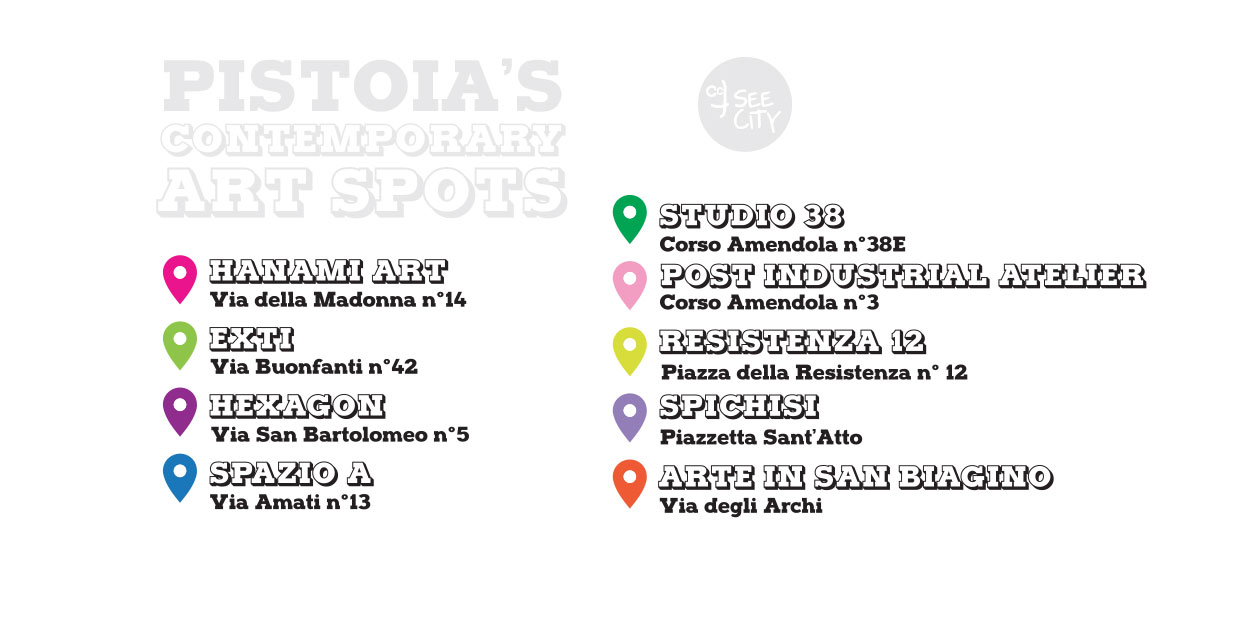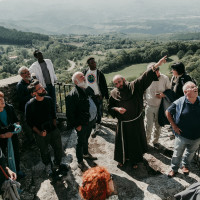
Stories by the “Creative Curious Travellers 2017” about the city of Pistoia. Thanks to: Giorgio Tesi Group | Discover Pistoia | NATURART | La Sala | FAI Giovani – Pistoia | BrickScape.it | Brandini – Pistoia | Comune di Pistoia | Pistoia Italian Capital of Culture 2017.
Text & Map by Ilenia Vecchio | Graphic by Michele Moricci

PISTOIA is wandering through narrow streets and alleyways. An intersection of streets with the most absurd and funny names: vicolo Malconsiglio, via dei Bacchettoni, via del Cacio, via delle Belle, via Abbi Pazienza. In the centre, the spectacular Piazza del Duomo with the Palazzo Comunale and the famous Baptistery of San Giovanni in Corte, with black and white stripes. The green or Prato serpentine of the famous ‘zebra’ churches of Pistoia. San Giovanni Fuorcivitas or Sant’Andrea, custodians of the famous masterpieces of Nicola and Giovanni Pisano and the Della Robbia.
The medieval aspect is therefore predominant. Ancient buildings with signs of old shops, ex-typographies and terraced houses with beautiful hidden entrances. Walking through Pistoia is immersed in a reality full of history, culture and traditions. But, exactly in the old heart of the city, “the contemporary triangle” of Pistoia is hidden. At the vertices of this contemporary fervour, three places symbol of worship: Chiesa di San Paolo, Basilica della Madonna dell’Umiltà – with the famous dome designed by Vasari (in imitation of the Florentine Duomo) – and Chiesa di San Bartolomeo in Pantano. A triangle with a centre, around Chiesa di San Leone, just as interesting. A triangle that, at times, turns into a quadrilateral, during the events at ex Chiesetta di San Biagino. Are you curious to discover all the places that create this particular geometric shape on the city map? Then follow us on our urban exploration, in search of independent spaces born to share contemporary art and creativity, in the Italian Capital of Culture 2017!

Do you want to download this Map? Click here!
Around Chiesa di San Paolo, first vertex of the “triangle”
The area around Chiesa di San Paolo counts three distinct realities, united by the research of the contemporaneity.
The SpazioA is located just behind the church, in Via Amati 13. The architect Giuseppe Alleruzzo is the founder of this art gallery with an international openness. In fairs all over the world, the name of Pistoia is known from New York to Brussels to Tel Aviv. Started in a non-profit space in Capostrada (today a studio that also hosts foreign artists), the project then moved to a former printing house in 2008. The space is beautiful, spacious and with white walls. A white gallery. Two rooms placed next to each other but with two separate entrances. A larger one consisting of two rooms and where are also the offices of the gallery, whose director is Arianna Pacifico. Here the most profitable part of the exhibition or the main artist is usually exhibited. The other smaller room has also two rooms and is considered as a Project Space. A first step to start a collaboration, a testing ground between the artist and the gallery owner. Therefore, depending on the exhibits, the two spaces are used either separately. Known more in Italy and abroad than by the local people of Pistoia, it has 90% of foreign visitors and an international program. Italian and foreign young artists exhibit here, with a rotation, once a year, of external curators. The mission is to be promoter in the world of the city, in the will to do research and have connections all over the globe.
In the same area, in Corso Amendola, there are two other realities. At number 38E, the gallery directed by Giulia Ponziani: STUDIO 38 Contemporary Art Gallery. At number 3, Post Industrial Atelier by artist Vincenzo di Piazza (in art, Vince).
Giulia’s gallery has been recreated inside a private home, the inherited grandparents’ house. And what you breath here is a familiar and informal air. Crossing the small entrance we find her office’s desk and two rooms for exhibitions. Next, there is a large and charming hall that the young gallery owner loves to animate with cultural initiatives. Like the Art Night events on Thursday: during the extraordinary opening of the shops, an artistic alternative on warm summer evenings. Reading, performance or, as the last Thursday of July 2017, the VideoArteVirale event based on projections realised by the Florentine collective. On the upper floor there is an apartment, two large rooms with huge windows that overlook the side of St. Paul Church: an enviable close-up view of the beautiful windows. The rooms are rich in art works, including those of past exhibitions exhibited in the gallery. Here you can see, choose and buy what you like. Antique furniture cohabit and divide the space with contemporary works. The precise intention of the gallery owner is to show how even in a private home furnished in a classic way the contemporary can well coexist.
This love for old buildings and the invasion of contemporary art, we perceive here, is confirmed by the initiatives carried out and promoted by Giulia, like the invention of three years ago of the “4 artists in 4 palaces” format; following a small artistic path in the curated and careful research of scenographic halls hidden in ancient palaces, the idea was then extended to six places with Pistoia Contemporary Arts Weekend: a three day dedicated to photo, video, painting, sculpture, visual poetry and related side events. In the May 2017 edition, the formula of the six buildings is permanent, with the help of three curators for photography, installations and video-art. Through these events, performative art always plays with visual art. Among the various projects to mention also the Art garden that involves the gardens of Piazza d’Armi, Puccini and the cloisters of the city. A space that, like Giulia, in the creation of collateral events, always looks for new, emerging and unknown voices.
Vincenzo instead, collector and artist, opened in June 2016 an artist’s studio/workshop. An atelier with its own works as ‘variables in permanence’ and others’. From his work experience as impresario he learned a deep knowledge of materials. A will also ecological, well visible by observing his works. His passion is evident. In fact, he perceives the underlying fun from which his creations were born. It’s a material art that leads us to touch the works (and here you can do it!), the sense of sogginess or liquidity that many transmit, and the choice of the used material is important. There are even works that can be composed and decomposed (finding the right or proper combination of letters). Not just works to be manipulated but also to wear. Neither I couldn’t resist, attracted by ‘Straitjacket’, like every self-respecting art crazy lover. An art therefore participated and experiential as contemporary art should be.
The same space of the atelier was then transformed by Vincenzo according to an industrial design with niches and corridors of sheet metal. The preferred materials are in fact iron, bolts, stones, foams, cement, silicone, nuts, washers, pins. Typically industrial materials, mixed according to a perfect and balanced fusion between art and craftsmanship. However, it is not just an exhibition place but also a meeting and meeting point for friends and artists.
Not really very close but always within the radius area of Chiesa di San Paolo, there is also another interesting reality: the study-showcase of Giuseppe Iozzelli, in art iogirom. The name is Resistenza 12 because it is located at number 12 of Piazza della Resistenza. A space dedicated to installations in open dialogue with the city. Starting from December 2015, six at intervals of two/three months alternated. The last one visible for two years is Question mark. A huge question mark on a straw mattress, consisting of masks that also enclose the previous installation. Volti dentro (masks without eyes, point and end of the punctuation mark). The perspective is external, from the window that at night lights up. A sign of question addressed not only to the outside world, but also to itself, in an individual research path that will lead to Solution. From the heavy sense of the question that contains all the great questions to a change of perspective determined by a sense of lightness with an installation that will be suspended and weighing only 5 grams. Resistenza (resistance) or at most possibilities, as a request for interaction with the outside world. The same will to open a path to the world is also the basis of a future project: four Animanti as doors of the city. In fact, Pistoia today has only its walls, without doors, demolished in the past. For the artist it is something crazy, a closure to communication with the outside. Hence the idea of rebuilding four doors that open from the physical spaces to the existential ones of the soul towards the world, celebrating four steps: the origin of light, reflection, evolution of life and awareness of thought. An example is the first Animante by the artist placed along the road between Olmi and Quarrata.
Around Basilica della Madonna dell’Umiltà, second vertex of the “triangle”
Workshop/artist’s atelier is also the idea of Stefania Salvatori. In December 2016, she gave birth to HANAMI Art, next to Basilica della Madonna dell’Umiltà in Via della Madonna 14, a point of passage and a vivid stretch of everyday life in the city. Hanami is her stage name and is a wanted reference to the famous Japanese feast started by the Chinese Tang Dynasty. The blossoming of flowers in spring, intended as a rebirth of nature. Hanami means looking at the flowers from ‘hana’ flowers and ‘mi’ see and the symbol is the cherry blossom. Celebration of beauty, caducity and rebirth, in symbiosis with the cycle of human nature. Born from her strong passion for painting, HANAMI Art is both a lab where she paints bags, sweaters, fabrics, and organises workshops, but also an atelier where she exhibits paintings and works by her and other artists. This space is therefore in the artist’s will a meeting place, a space for exchanging ideas for local artists and art lovers.
Around Chiesa di San Bartolomeo, third vertex of the “triangle”
At the third vertex of this ideal triangle of Pistoia’s contemporary art, we find the Chiesa di San Bartolomeo. A popular district that a group of young artists would like to redevelop, creating a real cultural hub, this is the challenge.
In Via Buonfanti 42, it will open a multi-purpose cultural space. In a former printing press, from which EXTI is born.* They are Rachele Salvioli (photographer, also famous for the atypical music parties organised in villas, woods and historic spaces, unknown to most – among the last ones, summer 2017, “Psychedelic Garden Party” at the Puccini Bonacchi Park and then in her garden at Novenovine) and the duo Federico Fiori and Francesca Lenzi from Nub Project Space. Three rooms with an entrance from a very impressive courtyard and the neon sign. A place that in the idea of the three creatives will have to be animated by lights and scenes and appear in the eyes of the adventurer always different. A scenic change at least once a month. Exhibitions will be set up and, in line with Rachel’s parties, there will be space for live music, with a dedicated station and a rotation of three/four groups to play. Probably part of the space will also be dedicated to co-working (a reality that has not yet taken root in the city).
* Update, February 2019 – EXTI has officially opened (both as events and co-working space) but changing its name and calling itself instead like its address, written all in one word: VIABUONFANTI42.
The same spirit then moved their friend, the tattooist Gigi Fagni. Right in via San Bartolomeo 5, at the end of August 2017, Hexagon Tattoo opened, a tattoo studio but not only. The idea is, in the owner’s words, to create something hybrid and multifunctional, with a focus on aesthetics and research. The first entrance room in fact will be designed as an open space, a real exhibition space, with reception. On the side, the real studio and in the last room at the back, the painting workshop of his friend Daniele Capecchi. The choice fell on this fund, once former hairdresser and remembered above all as the seat of a furrier’s in the past, because it is a place near the centre. It is practically behind Piazza Duomo and at the same time near the station, so as to be easily reachable by customers coming from outside Pistoia. The goal is to revitalise the heart of an old neighbourhood making it a place in the limelight for events, in collaboration and synergy with the EXTI space, in the parallel street but part of the same cluster. The idea is to give life to performing arts, visuals, exhibitions, while maintaining the continuity of tattoos, with particular attention to the figure of the tattooist as artist and vice versa.
Not by chance, the same place in the past was at the centre of a creative revolution, in particular about design, by Superstudio and Archizoom: in 1966, right in Via San Bartolomeo, at number 17, in the Jolly Art Gallery, there was the exhibition ‘Superarchitettura’ – as recalled by ‘Creative Design was born in Pistoia‘ – an exhibition set up in the frescoed halls of the Palazzo Comunale in August 2017.

Around Chiesa di San Leone, in the centre of the “triangle”
This same desire to redevelop and seek the identity of a neighbourhood is the basis of the mission of a local cultural association called Spichisi. This group was born in 2013 with the intent to move people of Pistoia to rediscover places of their own city full of art and history, places abandoned to degradation and relegated to the condition of ‘piss-house’ or unknown to most people, through cultural and playful actions or film/documentary screening. We can remember the Silent Night or the mapping at Ospedale del Ceppo (March 2016), for example, or the debut at the Biblioteca Forteguerriana (December 2013).
And precisely at the centre of this ideal “contemporary triangle of Pistoia”, it will take place the redevelopment project of an area close to Chiesa di San Leone: known for its baroque frescoes, recently restored, on the occasion of Pistoia Capitale della Cultura 2017, it hosted the famous sculptural group of ‘La Visitazione’ by Luca della Robbia. But even before the restoration of the church, this place was the protagonist of an action by Spichisi – on the occasion of the film festival Presente Italiano – with the screening of “Gesù è morto per i peccati degli altri” (April 2015). This time it deals in particular with the redevelopment of Piazzetta Sant’Atto, adjacent to Via dei Bacchettoni. An area where Spichisi has already intervened during the Silent Wood event on 13th June 2015, with the desire to create another park in the city. Not only architecture will be restored: it will be a real revaluation of the area thanks to permanent installations of contemporary art and the involvement of well-known street artists. It is also planned to create a garden, with the support of a local plant nursery. The project, still in itinere, proposed to the municipal administration in the 2017 summer, is still struggling with the scouting of sponsors and artists. The proposal is to involve first of all the citizens, inhabitants of this degraded area, in an open dialogue, with the will to instill a change of mentality, the desire to live the public space in a responsible way, to bring back beauty where once there was but now the ugliness and the uneasiness reign. A project that wants to be for the creative group not a point of arrival but of launch for other similar initiatives in other places in need of the city.
Around Chiesetta di San Biagino, and here is the “quadrilateral”
This “triangle of contemporaneity” then becomes a quadrilateral if one considers the small and deconsecrated Church of San Biagino with the initiatives of Arte in San Biagino. The church, in Via degli Archi, is rented for cultural events of various kinds, especially for art exhibitions.
In July 2017, it hosted the works of a local young artist, Francesco Calistri, aka Hirdilak. In this case, the artist has recreated a sort of initiatory and mystical journey of the I, divided into stages. Self-taught, with an exaggerated love for Tiziano and Tintoretto, he pursues his personal research for a return to painting as a lighthouse of art. He’s moved by the lightning that struck him as a child visiting the Musée d’Orsay in Paris. Painting is immortal for him and he must know how to speak an emotion to the observer, otherwise the artist has failed. This research for an intimate relationship is also reflected in the choice of the setting of the place. In dim light and sometimes almost dark, it was lit only by faint lights. In all, thirty oil paintings and only four drawings. Portraits, artist’s rooms, landscapes and exotic characters with a strong empathic and emotional charge, to end with the materiality of the nudes. Among these also her partner, the photographer Eleonora Chiti. The “Guide” face of the poster is like a guide to the path. The drawings are touched with the drawn face, lighthouse and icon. The placement, at both ends, of the self-portrait of the young painter and of “Elijah on the chariot of fire” is also symbolic. The “Self-portrait with hat” at the altar is like a saint to pray to reach or aspire to the artistic vocation. A pillow was even provided for kneeling. And in the counter-façade, as a symbolic icon, Elijah. Mindful of the function to which the place was once voted. This exhibition consecrates him to the poetic fire of painting.
 All these realities are different but they all united by the same passion and mission. It is interesting to note how places full of history and traditions are the background of projects dedicated to sharing of new languages and knowledge. Contemporary spaces, a crossroads of our times, in the research for an experiential and inclusive art. Open to the community and aimed at redeveloping the city, to make it simply more beautiful and experienced, more contemporary and co-lived.
All these realities are different but they all united by the same passion and mission. It is interesting to note how places full of history and traditions are the background of projects dedicated to sharing of new languages and knowledge. Contemporary spaces, a crossroads of our times, in the research for an experiential and inclusive art. Open to the community and aimed at redeveloping the city, to make it simply more beautiful and experienced, more contemporary and co-lived.
Do you want to download the Map?
Click here to have it always with you, even offline, or to print it!




